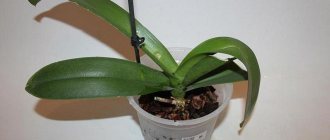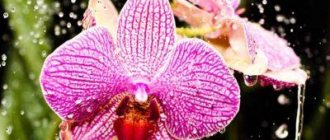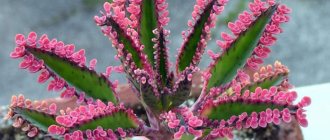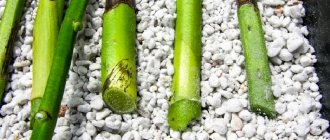- September 15, 2018
- Flowers
- Yulia Saltrukovich
The phalaenopsis orchid is one of the favorite and most common indoor plants that requires virtually no care. Sufficient lighting, optimal indoor air humidity and proper watering - perhaps this is all you need for a comfortable life. However, many people think about how to water phalaenopsis. Which watering method should I choose and how often should I do it? Let's try to find answers to these questions together.
Phalaenopsis
This variety of orchids is an amazing plant, the distinctive feature of which is its unusual root system. Airy and powerful, in nature it is attached to tree roots, snags and other supports. At home, a special air substrate is prepared for orchid roots, which allows the roots to breathe and absorb all the necessary substances directly from the environment. This is why it is so important to water phalaenopsis correctly. How to do it? You will learn the answer to this question from the article.
There are several watering methods, each of which will provide the plant with the necessary amount of moisture. You can water it using the usual method, you can immerse the roots of the plant in water, you can offer the orchid a shower. Some people prefer a “passive” watering method, leaving small ice cubes on the surface of the substrate.
What is the best way to irrigate Phalaenopsis?
Do I need a special composition of water?
Under natural conditions, phalaenopsis are saturated with water from tropical rains. And at the same time, the culture is developing well. Therefore, ordinary water is suitable for watering at home.
Which water should you choose?
Since in nature water falls on orchids after tropical rains, it should be soft at home. A large amount of salts can destroy the plant.
If you take water from the tap, you need to boil it or let it sit for several days. You can use distilled water. As for the water temperature, it should be 3-4 degrees higher than room temperature. Such indicators contribute to the active formation of leaves and buds. Watering with cold water will cause disease and rot to develop.
What can I add for better growth?
In order for the orchid to grow more actively, you can add a liquid fertilizer complex to the water when watering. The procedure is carried out 1-2 times a week , but only during the period of active flower growth. Flower growers also recommend adding oxalic acid to the water (in a ratio of 1:10).
When should this be done?
Remember once and for all. So as not to think and wonder how to water phalaenopsis. You need to water the orchid only when its roots and substrate are completely dry. Moreover, the dried roots can calmly stand for a few more days - it definitely won’t get any worse. But you will definitely be sure that watering the roots now will definitely not harm them.
The speed of drying of the substrate is also important. The best option is when the substrate and roots dry completely within one day. This trend applies to all epiphytic orchids. A lot depends on the weather outside the window. On a hot sunny day, moisture can completely disappear within 24 hours. But in rainy weather or winter it takes much longer.
When does a plant experience an increased need for water?
An increase in the frequency of watering phalaenopsis orchids may be due to the following factors:
- The period of active growth or flowering.
- Changes in environmental conditions - temperature, air humidity.
- The onset of summer.
- Heating season indoors.
Don't forget that the larger your plant, the more moisture it needs.
Phalaenopsis orchid requires special attention regarding watering . But if the procedure is carried out correctly and the frequency of watering is comfortable, your beauty will delight you with its good appearance and long, unusual flowering.
Phalaenopsis is the most popular type of orchid for gardeners. On our website you will find articles about how to care after purchasing in a store, how to determine that a plant needs replanting and how to plant it correctly, how to fertilize a flower, and also how to separate the baby from the peduncle, stem and root.
What should you pay attention to?
It happens that even in the hot summer, phalaenopsis is in no hurry to dry out. This means it's time to change the substrate. A fraction that is too fine takes longer to dry, so it is worth replacing it with larger particles, which will also provide more free space for the roots.
If it is difficult for you to navigate the root system of a plant and you do not know how to water phalaenopsis, pay attention to the statistics. As a rule, in winter the orchid is watered once every two weeks. In summer - every 2-3 days. In spring and autumn, a single watering for seven days is sufficient. But this is conditional data. Each orchid behaves differently depending on the degree of light and air humidity.
If you are confused about how dry the substrate is and how to water your phalaenopsis, consider the following orientation methods.
Care errors and their consequences
Excessive watering
Excessive amounts of moisture lead to failure of absorption of nutrients and water itself. As a result, the roots begin to rot and pathogenic bacteria develop. Increased air humidity leads to accelerated development of rot and pests. If the soil is not allowed to dry completely, the phalaenopsis will die.
Inadequate
If there is not enough moisture, the roots also suffer: they dry out and the plant dies. But a characteristic feature of phalaenopsis is the fact that before dying, the culture throws out a peduncle and new flowers. Therefore, it seems to the gardener that such insufficient watering is optimal, which is why there is no question of saving the plant.
How do you know if a plant can be watered?
Here are some simple rules.
- Focus on the weight of the pot. Take it in your hand immediately after pouring it - fix its weight in your head. Do the same after a few days. If it has “lost weight” significantly, the phalaenopsis needs watering.
- Carefully remove the top layer of bark. If the next substrate is wet, there is no need to water the plant.
- Stick a wooden stick into the middle of the pot. And as soon as you want to water the plant, take it out and look carefully. If it is still wet, postpone watering for a few days.
- Use a transparent pot for the orchid. This way you can clearly assess the condition of the substrate and the degree of moisture in the roots.
What does it depend on?
Depending on the soil type . Different soils absorb moisture differently, for example, sand absorbs water very quickly, but is not able to retain it, unlike clay soils, which do not absorb water well, but retain it for a long time (about what is included in the soil for phalaenopsis orchids and how to make your own substrate for growing plants, read here)- From environmental humidity . The higher the environmental humidity, the less watering the plant requires.
- From the indoor temperature . The higher the temperature, the more moisture the flower needs.
- Depending on the time of year and the length of daylight hours . In summer, watering should be more frequent and intense than in winter.
- From the size of the plant . The larger the plant, the more water it absorbs.
- From the size of the pot . A pot that is too small may not hold the volume of water needed to feed the phalaenopsis. In a pot that is too large, water may be “lost” on the way to the root and not reach the plant in sufficient quantities (read about how to choose the right pot for phalaenopsis here).
- From the age of the plant . During the growth period, the need for water increases.
How to determine that a plant needs moisture?
- Use your own finger . Lightly dig up the ground 1-2 cm and insert your finger to a depth of 4-5 cm. If the soil is wet, then you can wait to water it; if your finger remains dry, then it’s time to act.
- Wooden stick . If you don’t really want to get your hands dirty, but need to check the flower, then a small thin wooden stick will help you out. Instead, you can successfully use a regular pencil or toothpick. The principle is exactly the same as with a finger.
- Rhizome color . If the color of the root peeking through the ground can be called gray, then watering should not be postponed.
- Weight of the pot . In my opinion, the most unreliable method, but it is often used by experienced flower growers, so we will also get to know it. After thoroughly watering the phalaenopsis, take the pot in your hands and remember its approximate weight. Next time, before watering, take the pot in your hands again and determine offhand how much the weight in your hands differs from the weight of the pot with the plant you just watered. Is it very different? So it's time to water.
How to water phalaenopsis at home?
The best way to water is to completely immerse the pot in a container of warm water. You can immerse the plant for 15-20 minutes in the warm season. In winter, five minutes is enough for the roots to receive the required amount of moisture. After this, you need to remove the pot from the water and allow excess liquid to drain. Watch this carefully so that there is no moisture left at the bottom - it can cause rotting of the roots.
By the way, this procedure is best performed in the morning so that the plant can dry completely by evening. There is one more point here - orchids are especially active in “drinking water” in the morning and afternoon. At night, the plant, like most others, falls asleep. If you wet the substrate in the evening, it will take longer for the roots to dry out.
How often should this be done?
Reference. The frequency of watering depends on the conditions in which the plant is located. For each individual orchid, the frequency of “water procedures” should be individual. It is believed that in summer plants need more water; in winter, the frequency of watering is reduced.
But at the same time, you need to monitor the condition of the phalaenopsis and the surrounding temperature. In the middle zone, summers can be quite cold, then the plant will not need a lot of moisture. In winter, at hot temperatures, the plant needs a lot of moisture, especially if it is located near heating devices.
Shower for orchids
You can dramatically transform your plant if you know how to water phalaenopsis orchids at home. It is believed that a hot shower works wonders for many living creatures on earth. This rule also applies to orchids. True, it is necessary to separate the concepts of “shower” and “hot”. If everything is done correctly, they will not be afraid of any diseases, and they will begin to bloom even more beautifully.
A simple shower is good for phalaenopsis. For many other orchids it is undesirable. For example, hybrid Cambrias, “slippers” and Miltonias should not be watered. It is also important to choose the optimal temperature - it should not exceed 40 degrees. Unless, of course, you want to cook your plant.
Popular questions and answers
We talked about the problems of growing phalaenopsis with agronomist-breeder Svetlana Mikhailova.
How to choose phalaenopsis?
The leaves should be a healthy color, without dried out tips, fleshy, with a waxy sheen. The aerial roots are healthy, powerful, without signs of dryness, not rotten. They sit tightly in the substrate. If you move it slightly, they do not dangle sluggishly, but hold tightly to the substrate. The flowers are tightly held on the peduncle, with a bright color, without signs of disease.
What should a pot for phalaenopsis be like?
Since the roots of phalaenopsis perform the function of photosynthesis, they must be in the light. Therefore, the pot must be transparent. You can plant these orchids in plastic pots, but they are very light. And given that the substrate is airy, there is a high risk that the plant will tip over. Glass pots are more reliable in this regard.
Why do phalaenopsis leaves turn yellow?
Leaves turn yellow when the temperature is incorrect (usually too low), lack of light or moisture.
Why do spots appear on the leaves of phalaenopsis?
This could be sunburn if the plant was sprayed with water and it was exposed to the sun's rays. But most often it is a sign of disease or pests.
What do you need to know?
After a shower, be sure to blot all the “secluded” places of the orchid with a dry napkin. Accumulation of moisture in the rosette or between the leaves can lead to rot. All leaf sinuses and the growing point itself deserve close attention.
Never water a dormant plant in the shower. As a rule, this is the autumn-winter period.
What water should I use for irrigation?
This question is also of no small importance. You know very well what kind of water flows from our taps. You can imagine what it can do to such a delicate plant as an orchid. Water intended for irrigation must be clean and soft. You can filter it and boil it in advance. These methods allow you to purify water from various impurities that are harmful to the fragile plant. Many people use distilled water for irrigation.
By the way, it is precisely this that is the ideal option for watering the plant, since it does not contain pathogenic impurities and heavy metals. But at the same time, it does not contain microelements and salts necessary for normal plant growth. Therefore, if you prefer to water your phalaenopsis with distilled water, keep in mind that the orchid needs microelements, which can be added along with fertilizers.
Periods of increased procedure frequency
There are periods when an orchid needs more frequent watering. Let's look at them:
Increase in ambient temperature . In hot climates, the plant produces more moisture and consumes more of it.- Excessive sun rays . An orchid located on the sunny side of the house window requires more watering than the same orchid located in the shade.
- Flowering period . During flowering, the plant spends a lot of juices to form flowers, secrete nectar that attracts pollinators, and, naturally, needs increased nutrition.
- Low humidity . In a dry climate with air humidity less than 50%, phalaenopsis requires frequent watering.
- Large plant size . The larger the orchid, the more nutrients and water it consumes.
How to water a blooming orchid?
As soon as you notice young buds, you need to completely reconsider the plant’s watering regime. You need to create all the necessary conditions for your orchid to turn from a nondescript stem with spreading leaves into a beautiful flower that pleases the eye.
During the flowering period, phalaenopsis produces seeds. They are very small and barely noticeable. Volatile, they can travel several kilometers from their birthplace. In nature, when the rainy season begins, the seeds cannot fly long distances. Therefore, it is advisable to adhere to the following irrigation mechanism:
- You only need to moisten the roots of the plant, trying to saturate them as much as possible with moisture, but not drown them.
- If the air in the room is too dry, you can spray the leaves with a sprinkler, but do not touch the secluded places of the plant. If this does happen, remove excess moisture with a dry cloth.
- During flowering, the orchid also needs to be watered as the substrate dries. As a rule, this is once a week.
In the autumn-winter period, phalaenopsis “falls asleep”, so it needs less moisture. Optimal regimen: once every 10 days or two weeks. It is not necessary to adhere to such strict rules. If your apartment is warm and humid enough, you can provide watering much more often.
Features and nuances
For non-standard cultivation
After insufficient watering, it is often necessary to revive phalaenopsis orchids, which do not have horses at all.
How to water them? How will the plant absorb the required amount of moisture ?
As is known, epiphytic plants can absorb moisture from the environment not only with their root system, but also with their leaves .
It is in this way that the trunk will be fed during the period of resuscitation, when it will completely lack roots.
The watering process is carried out as follows:
- acidified water is collected into the container ;
- Place the plant over a vessel with water so that it does not touch the water;
- As leaves , they will absorb the required amount of moisture;
This method will help not only to water the dried trunk, but also to grow a new root system .
Sometimes tropical plants are grown without flowerpots, this gives a certain exoticism to the room.
In such cases, watering is carried out using a sprayer ; the water should be warm at any time of the year.
If we talk about how often to water a phalaenopsis orchid at home, then this procedure is repeated once or twice a week, depending on the temperature in the room and its lighting.
When transplanting
After transplanting a young or adult plant, it is not recommended to water it for 7-10 days .
After transplanting, the orchids are not watered for some time.
There are several reasons for this:
- Before transplanting, an adult plant is usually cleared of the old substrate by abundant watering; during this period, the plant accumulates moisture in the roots ;
- Before placing the filler in a pot or bowl, wash it and soak it briefly in water; the substrate is saturated with enough moisture for several days.
If you start watering the plant earlier than expected, the risk of root rot increases .
If foam is used in the substrate, watering is done more often. Moss and expanded clay will extend the time the plant stays without watering for 2-3 days.
Moss extends the time between waterings.
In dry microclimates
Dry air in an apartment can negatively affect the growth of phalaenopsis orchids.
Such a microclimate can destroy the plant. To prevent this from happening, it is necessary to regularly water and spray the trunk.
Important! The intervals between watering in rooms with dry air are reduced to 2 days in the summer and 4-6 days in the winter. Spraying can be done daily, but before doing this you should carefully inspect the plant.
With supplements
For weakened trunks, watering can be carried out using fertilizers prepared from scrap materials:
- If there is insufficient watering, the orchid leaves wither; this can be combated with the help of sweet water, which is used to water the trunk. It is prepared simply: a teaspoon of sugar is diluted in a liter of water and the plant is watered once a week. If you do this more often, you can provoke a disruption of the microflora of the substrate;
- Succinic acid will help the phalaenopsis orchid cope with the adaptation period after transplantation and will facilitate the absorption of nutrients from the substrate. Watering with the addition of this drug is carried out once a month, this is quite enough to stimulate the growth and forcing of flower stalks.
In addition, other equally effective care products are often used; this is a topic for a separate article.
What to do with a potted plant immediately after purchase?
Many people make a catastrophic mistake when they buy a new orchid and immediately begin to remake it in their own way (change the pot, remove excess roots, water, etc.). This cannot be done. Phalaenopsis grew calmly in familiar conditions, where there was optimal air temperature and humidity, but now its living conditions have suddenly changed. It is clear that the plant is under stress. Therefore, he needs to undergo a short quarantine.
It consists of protecting the orchid from other plants and direct sunlight. In addition, it is recommended not to water it at all for one week. This is necessary in order to identify pests and destroy them in a timely manner. 5 days after purchase, you can begin to accustom the orchid to new living conditions, giving it the opportunity to bask in the sun’s rays and providing moderate watering.
Please note that after transplantation, phalaenopsis cannot be watered for two weeks. In winter, it is not advisable to spray the leaves of the plant with water - this can lead to hypothermia. Now you know how often to water phalaenopsis. All that remains is to wish you success in caring for this beautiful plant!
Why is it important to follow a routine?
Each type of plant has its own individual watering needs and phalaenopsis is no exception. If watering is insufficient, the flower will begin to “starve”; the lack of nutrients will lead to the death of leaves, stems, and in severe cases, parts of the root, which entails the death of the plant.
ATTENTION : If watering is excessive, the increased moisture will cause the appearance of uninvited neighbors: fungal and bacterial diseases, pests.
We talked more about how and what to water phalaenopsis during flowering and after transplantation in a separate article.











